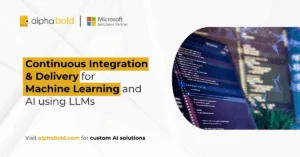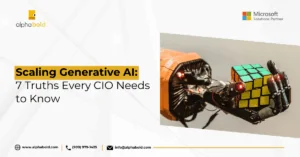Table of Contents
Introduction
As intelligent automation technologies mature, organizations across industries increasingly evaluate their potential. While the benefits—from increased efficiency to new revenue streams—are compelling, implementing generative AI (GenAI) requires thoughtful financial planning and cost analysis. Decision-makers must consider both initial expenses and long-term financial impact.
At AlphaBOLD, we emphasize using a structured framework to guide adoption—because when you follow a proven approach, your organization is more likely to see faster returns and predictable outcomes.
This article provides a practical approach to evaluating the total cost of ownership (TCO), helping you build a business case grounded in both projected costs and strategic value. By approaching the process methodically, you can ensure that decisions align with your organization’s goals and resources.
Understanding the Total Cost of Ownership
Implementing generative AI goes far beyond licensing software or subscribing to cloud platforms. A complete TCO analysis must account for the full lifecycle of your initiative, including:
- Initial Capital Expenditures: Hardware, software, and infrastructure setup costs
- Integration Expenses: Connecting AI systems with existing technologies and workflows
- Personnel Costs: Hiring specialists or training existing staff
- Ongoing Operational Expenses: Compute resources, API calls, and maintenance
- Governance and Compliance Costs: Ensuring responsible use and regulatory adherence
It is easy to underestimate the true TCO by focusing narrowly on acquisition costs, neglecting operational demands and change management. A structured analysis helps prevent surprises and enables accurate ROI forecasting. According to Statista, deploying such an application may cost anywhere from $600,000 to $1.5 million, depending on the project’s size and complexity.
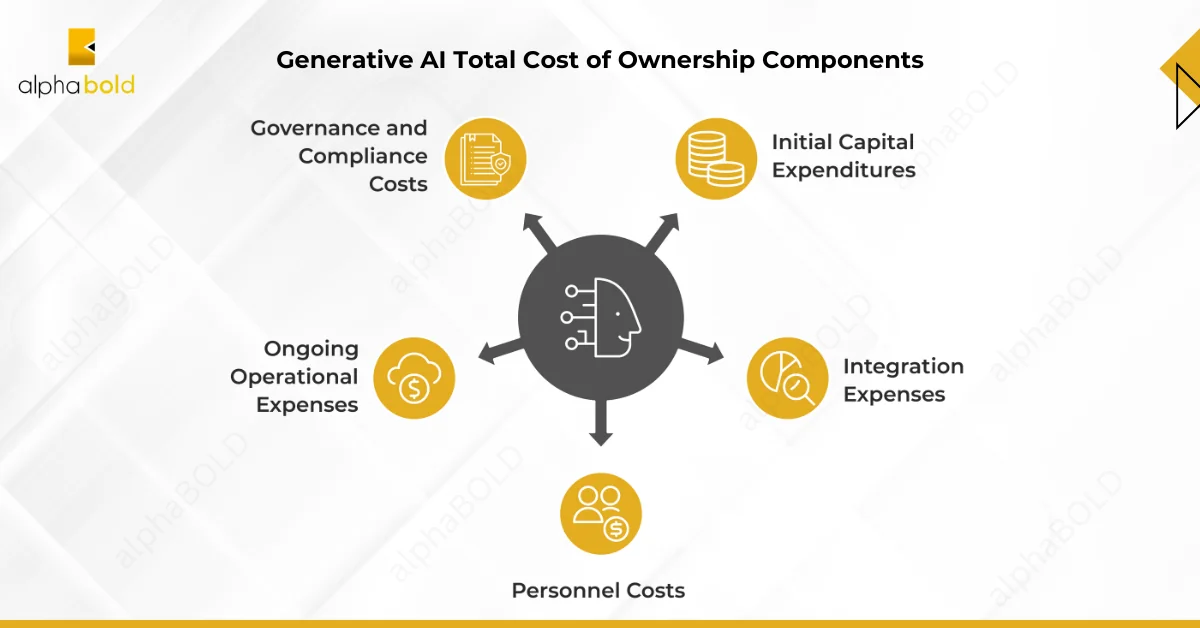
You may also like: 4 Key Steps for Business Leaders to Implement AI
Initial Investment Considerations
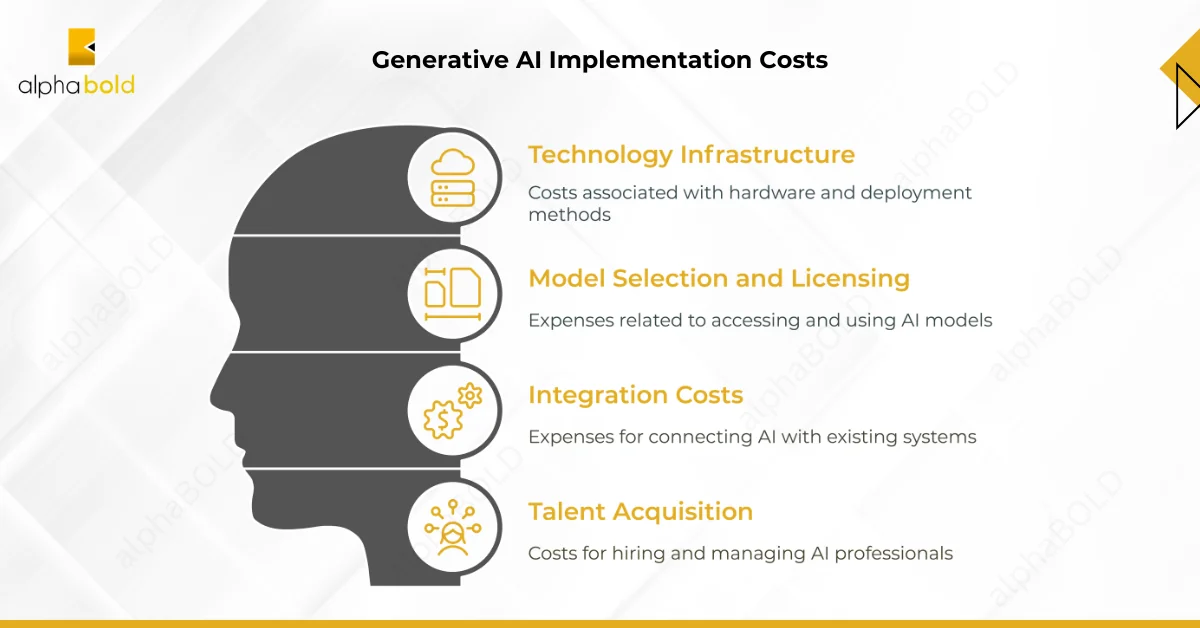
Technology Infrastructure:
Depending on your implementation approach, infrastructure requirements can vary significantly:
- On-premises deployment: Requires substantial upfront investment in specialized hardware like high-performance GPUs or TPUs. For organizations running large-scale generative models locally, initial hardware costs can be significant depending on the scale and complexity of your implementation.
- Cloud-based solutions: Reduces upfront capital expenditure but introduces variable operational costs based on usage. This approach provides flexibility but requires careful monitoring to prevent unexpected spending.
- Hybrid approaches: Combine on-premises resources for sensitive workloads with cloud services for scaling or specialized capabilities, balancing capital expenses with operational costs.
Industry experience suggests your organization will often benefit from hybrid approaches that balance security requirements with cost considerations, mainly when dealing with sensitive data that requires careful handling.
Model Selection and Licensing:
The cost of accessing Generative AI models vary dramatically based on your chosen approach:
- Commercial API services: Pricing is typically based on usage (tokens, requests, or compute time). While convenient, costs can escalate quickly with increased usage.
- Open-source Models: Lower initial licensing costs but require more technical expertise and infrastructure investment to deploy and maintain effectively.
- Custom Model Development: Highest upfront investment but potentially lower long-term costs and better performance for specialized use cases.
The right approach depends on your specific use cases, technical capabilities, and scale. You will often find that starting with commercial APIs allows for quick experimentation before making more significant investments in custom solutions as usage scales.
Integration Costs:
Connecting the systems with existing business applications and workflows represents a significant portion of implementation costs:
- API Development and Customization: Creating interfaces between GenAI and existing systems.
- Workflow Redesign: Modifying business processes to effectively leverage AI capabilities.
- Data Pipeline Development: Building robust systems to feed relevant data to AI models.
These costs can vary widely based on the complexity of your existing systems and the depth of integration required. In many implementations, integration expenses can represent a substantial portion of the total project budget and should be carefully estimated during the planning phase.
Talent Acquisition:
The human element of Generative AI implementation often represents a substantial investment:
- AI Specialists: Data scientists, ML engineers, and prompt engineers command premium salaries in today’s market.
- Implementation Teams: Project managers, business analysts, and change management specialists who understand the technology and business needs.
- Legal and Compliance Experts: Professionals who can navigate the evolving regulatory landscape around AI use.
You must decide whether to build internal capabilities, partner with external specialists or combine both approaches. Industry experience suggests that a blended approach—building core internal competencies while leveraging external expertise for implementation—provides the best balance of cost-effectiveness and knowledge retention.
Ongoing Operational Costs
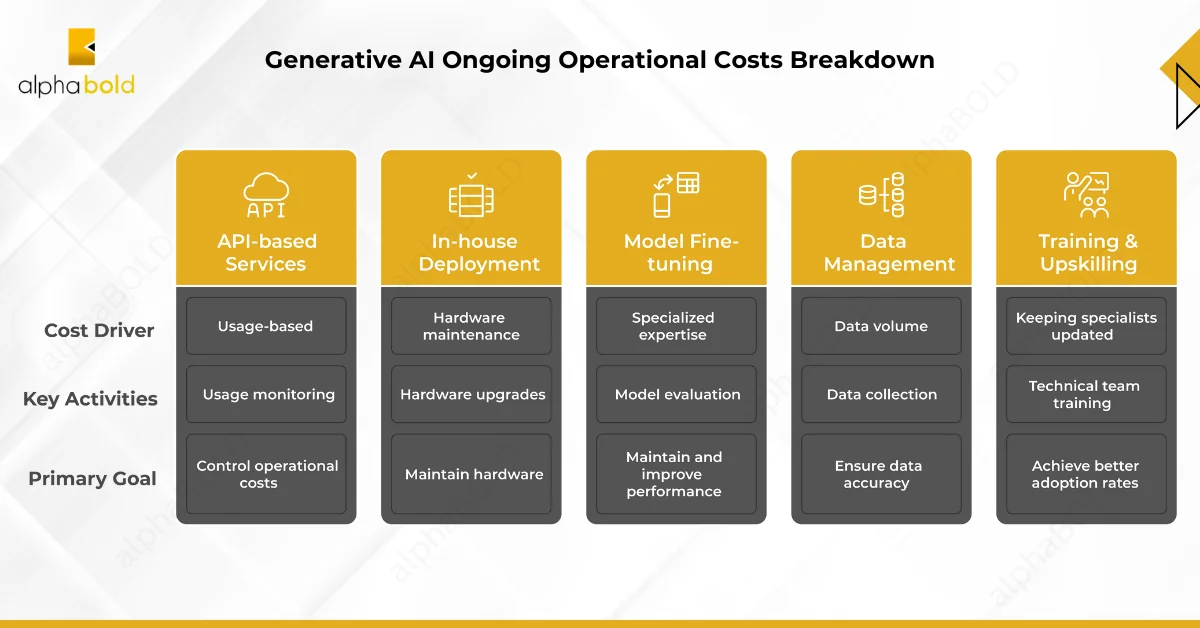
Compute Resources and API Usage:
Operational costs can be substantial and need careful management:
- API-based Services: Costs scale with usage, typically measured in tokens, requests, or compute time. Enterprise implementations can quickly grow as adoption increases across the organization.
- In-house Deployment: Even after initial deployment, ongoing hardware maintenance, electricity, cooling, and periodic upgrades represent considerable expenses.
Usage monitoring and optimization strategies are essential for controlling operational costs, particularly as GenAI adoption grows within your organization. Setting up dashboards and alerts for usage tracking can help prevent unexpected cost overruns.
Model Fine-tuning and Maintenance:
Generative AI models require ongoing refinement to maintain and improve performance:
- Fine-tuning: Adapting models to specific use cases and updating them as business needs evolve.
- Evaluation: Monitoring performance and addressing issues like drift or degradation.
- Versioning: Managing different versions of models across development, testing, and production environments.
These activities require specialized expertise and computing resources, representing an ongoing cost center that must be accounted for in long-term planning.
Data Management:
High-quality data is essential for effective Generative AI implementation:
- Data Collection and Preprocessing: Gathering and preparing data for training or fine-tuning.
- Storage and Security: Maintaining data repositories with appropriate access controls.
- Quality Assurance: Ensuring data accuracy and addressing biases or gaps.
These costs scale with the volume and complexity of managed data and the sensitivity of the information involved.
Training and Upskilling:
As the technology’s capabilities evolve, ongoing training becomes a notable expense:
- Technical Team Training: Keeping specialists up to date with the latest techniques and best practices.
- End-user Training: Ensuring business users can effectively leverage the associated tools.
- Leadership Education: Helping executives understand capabilities and limitations to drive strategic decisions.
If you treat training as an ongoing investment rather than a one-time expense, you will typically achieve better adoption rates and higher returns on your GenAI investments.
Measuring Return on Investment
Productivity Gains:
One of the most immediate returns from the technology comes through productivity improvements:
- Time Savings: Automating routine tasks or accelerating complex processes.
- Output Quality: Improving consistency and reducing errors.
- Capacity Increase: Enabling teams to handle larger workloads without proportional staffing increases.
These benefits can be quantified by measuring time savings, error reduction rates, and throughput improvements. For example, Professional services organizations, often see significant productivity gains when implementing GenAI for research and content creation tasks.
Revenue Generation:
Generative AI can drive revenue growth through several mechanisms:
- New Product Development: Creating offerings that weren’t previously possible.
- Customer Experience Enhancement: Increasing conversion, retention, and lifetime value.
- Market Expansion: Reaching new customer segments or geographical areas.
E-commerce and retail organizations frequently report revenue improvements through better product recommendations and personalized customer experiences.
Cost Reduction:
Beyond productivity improvements, this robust technology can directly reduce operational costs:
- Process Automation: Reducing manual effort in content creation, customer service, and data analysis.
- Resource Optimization: Improving forecasting and planning to reduce waste.
- Error Prevention: Catching mistakes before they result in costly remediation efforts.
Financial services and insurance organizations often achieve substantial cost reductions by automating document processing and analysis tasks that previously required significant manual effort.
Innovation Value:
Some benefits are more challenging to quantify but no less valuable:
- Competitive Differentiation: Creating unique capabilities that set your organization apart.
- Organizational Learning: Building digital capabilities that enable future innovations.
- Risk Reduction: Improving decision-making and scenario planning.
While these benefits may not appear directly on financial statements, they often represent significant long-term value that should be considered in ROI calculations.
Don't Let Uncertainty Delay Your AI Adoption
Our team will provide a clear, data-driven cost analysis and ROI forecast to ensure your implementation is both efficient and profitable. Contact us to start building your business case today.
Request a ConsultationRisk Management and Hidden Costs
Compliance and Governance:
The regulatory landscape around AI is evolving rapidly, creating potential hidden costs:
- Policy Development: Creating internal guidelines for responsible AI use.
- Monitoring and Auditing: Ensuring ongoing compliance with internal and external requirements.
- Remediation: Addressing issues when they arise, which can be costly if not planned for.
If you build robust governance frameworks from the outset your organization will face lower long-term costs than those that address these issues reactively.
Security Considerations:
Such systems introduce new security considerations that have financial implications:
- Prompt Injection Defenses: Protecting against manipulation of AI systems.
- Data Protection: Ensuring sensitive information isn’t exposed through AI interactions.
- Model Security: Preventing unauthorized access to valuable AI assets.
The cost of a security breach involving these systems can far exceed implementation costs, making this an essential consideration in your financial planning.
Ethical Oversight:
Ensuring ethical use requires ongoing investment:
- Ethics Committees: Establishing oversight groups to review AI applications.
- Bias Detection and Mitigation: Identifying and addressing unfairness in these systems.
- Transparency Mechanisms: Creating explainability tools for decisions taken using these tools and technologies.
These investments protect both your organization’s reputation and potentially its legal standing as regulations continue to develop.
Cost Optimization Strategies
Phased Implementation:
Rather than pursuing enterprise-wide deployment immediately, consider a staged approach:
- Proof of Concept: Small-scale tests to validate assumptions and build organizational support.
- Targeted Deployment: Focusing initial implementation on high-value, lower-risk use cases.
- Scaled Expansion: Growing your footprint based on demonstrated success.
This approach reduces initial investment requirements and allows for learning and optimization before significant financial commitments.
Hybrid Approaches:
Combining different implementation methods can optimize costs:
- Mixing Commercial and Open-Source Solutions: Using premium services for critical functions while leveraging open-source alternatives where appropriate.
- Balancing Cloud and On-Premises Resources: Optimizing for both cost and performance based on workload characteristics.
- Combining AI with Traditional Approaches: Using GenAI where it adds the most value while maintaining existing systems elsewhere.
If you’re looking to balance cost, performance, and risk, a thoughtfully designed hybrid approach is often the smartest move.
Managed Services:
Working with experienced partners can reduce both implementation costs and risks:
- Implementation Expertise: Leveraging specialized knowledge to avoid common pitfalls.
- Managed Infrastructure: Reducing the need for in-house technical expertise.
- Ongoing Optimization: Continuously improving performance and cost-effectiveness.
While managed services add costs, they often reduce the investment required for successful implementation while accelerating time to value.
The AlphaBOLD Approach to Cost-Effective Implementation
At AlphaBOLD, we’ve developed a comprehensive methodology for helping you implement Generative AI solutions that deliver maximum value at optimal cost:
- Strategic Assessment: We begin by understanding your business objectives and identifying where the technology can create the most value relative to investment.
- Financial Modeling: Our team develops detailed cost projections and ROI analyses for different implementation approaches, helping you make informed decisions.
- Right-Sized Solutions: We design implementations that match your organization’s scale, technical capabilities, and budget constraints.
- Phased Delivery: Our implementation approach prioritizes quick wins while building toward long-term strategic objectives.
- Continuous Optimization: We help you monitor costs and benefits over time, adjusting to maximize return on investment.
This approach helps your team achieve implementation success while maintaining project costs within reasonable parameters.
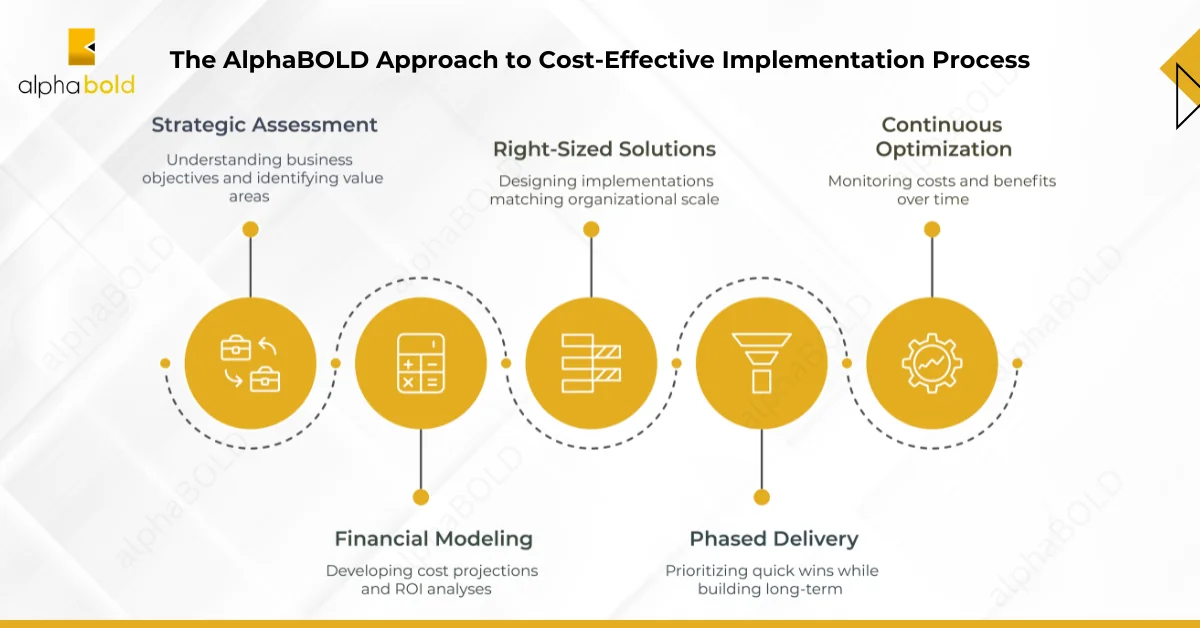
Implementation Scenarios: What to Expect
Manufacturing: Predictive Maintenance Implementation
Manufacturing companies implementing Generative AI for predictive maintenance typically focus on reducing equipment downtime and optimizing maintenance schedules. The financial profile generally includes:
- Initial investments in infrastructure and system integration.
- Ongoing costs for model maintenance and data collection.
- Benefits from reduced unplanned downtime and optimized maintenance scheduling.
Organizations in this sector often find that a phased implementation approach allows for learning and optimization before full-scale deployment.
Financial Services: Customer Service Enhancement
Financial institutions implementing this technology to improve customer service efficiency typically focus on handling routine inquiries and providing personalized recommendations. Implementation considerations include:
- Compliance and security requirements specific to financial data.
- Integration with existing customer relationship management (CRM) systems.
- Training requirements for customer service representatives.
Financial services organizations typically benefit from careful tracking of costs and benefits, allowing them to refine their implementation continuously.
Healthcare: Clinical Documentation Improvement
Healthcare organizations implementing this technology to assist with clinical documentation often face unique challenges related to regulatory compliance and integration with electronic health record systems:
- Higher initial integration costs due to complex legacy systems.
- Stringent security and compliance requirements.
- Need for specialized domain knowledge in healthcare terminology.
Experience shows that accounting for integration complexity in initial cost estimates is particularly important in healthcare implementations.
Conclusion
When approached strategically, implementing Generative AI represents a significant investment that can deliver substantial returns. You can develop realistic budgets and set appropriate expectations by understanding the full spectrum of costs—from initial infrastructure investments to ongoing operational expenses.
The most successful implementations share common characteristics: they begin with clear business objectives, take a phased deployment approach, carefully track costs and benefits, and continuously optimize your solutions. This approach maximizes ROI and builds organizational capabilities that enable future innovation.
At AlphaBOLD, our expertise enables us to identify cost-effective approaches that deliver measurable business value while managing the implementation risks of this robust technology.
Whether you’re just beginning to explore it or looking to optimize existing implementations, a thorough cost analysis is essential to making sound business decisions. By taking a structured approach to understanding the required investments and potential returns, you can ensure that your initiatives deliver lasting value to your organization.
Ready to Build Your Generative AI Business Case?
Our team can help you develop a comprehensive cost analysis and ROI projection tailored to your organization's needs and objectives. Contact us for a consultation, where we'll help you identify the most cost-effective approach to implementing Generative AI in your business.
Request a ConsultationExplore Recent Blog Posts




